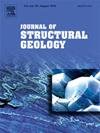Multi-millennia slip rate relationships between closely spaced across-strike faults: Temporal earthquake clustering of the Skinos and Pisia Faults, Greece, from in situ 36Cl cosmogenic exposure dating
IF 2.9
2区 地球科学
Q2 GEOSCIENCES, MULTIDISCIPLINARY
引用次数: 0
Abstract
This study investigates slip behaviour on overlapping, en echelon normal faults by analysing the slip histories of the Skinos and Pisia active normal faults over the past ∼20 kyrs using in situ 36Cl cosmogenic dating. New 36Cl data from the Skinos Fault and published Pisia Fault 36Cl data were modelled, with both sample sites located within an overlap zone and separated by an across-strike distance of 1–2 km. Our analysis reveals fluctuating slip rates, with the two faults alternating between out-of-phase and simultaneous slip. The Pisia Fault exhibited a slip rate of ∼0.5–0.75 mm/yr from ∼20 ka to ∼9.6 ka, increasing to ∼1.25 mm/yr until ∼5.2 ka. It then slowed to ∼0.25 mm/yr or less until ∼2.0 ka, before accelerating again to ∼1.25–1.5 mm/yr to the present day. The Skinos Fault maintained a low slip rate of ∼0.25 mm/yr or less from ∼20 ka to ∼6.4 ka, before accelerating to ∼2.0–3.0 mm/yr, persisting to ∼1.0 ka or possibly the present-day. Comparing their slip histories, the faults show periods of simultaneous slip between ∼6.4 ka to ∼5.2 ka and ∼2.0 ka to ∼1.0–0.0 ka, and out-of-phase slip occurred between ∼9.6 ka and ∼6.4 ka, and from ∼5.2 ka to ∼2.0 ka. Out-of-phase behaviour on faults across strike has now been observed on faults spaced across-strike at distances of 1–2 km, 10–20 km, and ∼100 km, raising the question of why it occurs. Possible mechanism(s), including rheological fluctuations within fault/shear-zone structures linked between the brittle upper crust and viscous lower crust and stress interactions, are discussed to explain the out-of-phase and simultaneous slip behaviour.
间隔紧密的断层间几千年的滑动速率关系:希腊斯基诺斯和皮西亚断层的时间地震聚集,来自原位36Cl宇宙暴露测年
本研究利用原位36Cl宇宙测年法分析了斯基诺斯和皮西亚活动正断层在过去~ 20年间的滑动历史,研究了重叠、阶梯形正断层的滑动行为。对来自Skinos断层的新36Cl数据和已发布的Pisia断层36Cl数据进行了建模,两个样本点都位于重叠带内,并以1-2 km的横向距离隔开。我们的分析揭示了滑动率的波动,两个断层在非相滑动和同步滑动之间交替。从~ 20 ka到~ 9.6 ka, Pisia断层的滑动速率为~ 0.5-0.75 mm/yr,直到~ 5.2 ka,滑动速率增加到~ 1.25 mm/yr。然后它减慢到~ 0.25毫米/年或更低,直到~ 2.0 ka,然后再次加速到~ 1.25-1.5毫米/年,直到今天。斯基诺斯断层在~ 20 ka至~ 6.4 ka期间保持了~ 0.25 mm/yr或更低的低滑动速率,然后加速到~ 2.0-3.0 mm/yr,持续到~ 1.0 ka或可能到现在。对比断层的滑动历史,断层在~ 6.4 ka ~ ~ 5.2 ka和~ 2.0 ka ~ ~ 1.0 ~ ~ 0.0 ka之间同时发生滑动,在~ 9.6 ka ~ ~ 6.4 ka和~ 5.2 ka ~ ~ 2.0 ka之间发生非相滑动。现在已经在距离1-2公里、10-20公里和~ 100公里的断层上观察到断层跨走向的非相位行为,这就提出了为什么会发生这种情况的问题。讨论了可能的机制,包括连接脆性上地壳和粘性下地壳以及应力相互作用的断层/剪切带结构内的流变波动,以解释非相和同步滑动行为。
本文章由计算机程序翻译,如有差异,请以英文原文为准。
求助全文
约1分钟内获得全文
求助全文
来源期刊

Journal of Structural Geology
地学-地球科学综合
CiteScore
6.00
自引率
19.40%
发文量
192
审稿时长
15.7 weeks
期刊介绍:
The Journal of Structural Geology publishes process-oriented investigations about structural geology using appropriate combinations of analog and digital field data, seismic reflection data, satellite-derived data, geometric analysis, kinematic analysis, laboratory experiments, computer visualizations, and analogue or numerical modelling on all scales. Contributions are encouraged to draw perspectives from rheology, rock mechanics, geophysics,metamorphism, sedimentology, petroleum geology, economic geology, geodynamics, planetary geology, tectonics and neotectonics to provide a more powerful understanding of deformation processes and systems. Given the visual nature of the discipline, supplementary materials that portray the data and analysis in 3-D or quasi 3-D manners, including the use of videos, and/or graphical abstracts can significantly strengthen the impact of contributions.
 求助内容:
求助内容: 应助结果提醒方式:
应助结果提醒方式:


